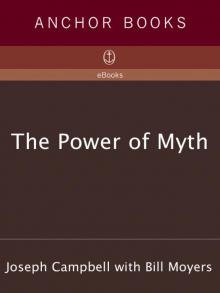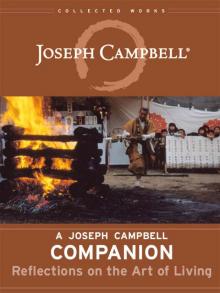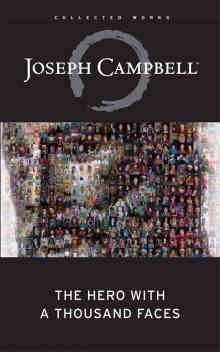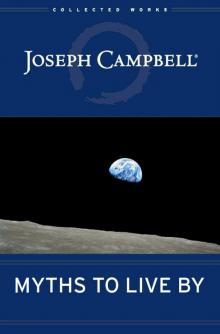- Home
- Joseph Campbell
The Hero with a Thousand Faces Page 6
The Hero with a Thousand Faces Read online
Page 6
Figure 9. Omphalos (gold phial, Thracian, Bulgaria, fourth–third century b.c.)
The World Navel, then, is ubiquitous. And since it is the source of all existence, it yields the world’s plenitude of both good and evil. Ugliness and beauty, sin and virtue, pleasure and pain, are equally its production. “To God all things are fair and good and right,” declares Heraclitus; “but men hold some things wrong and some right.”[52] Hence the figures worshiped in the temples of the world are by no means always beautiful, always benign, or even necessarily virtuous. Like the deity of the Book of Job, they far transcend the scales of human value. And likewise, mythology does not hold as its greatest hero the merely virtuous man. Virtue is but the pedagogical prelude to the culminating insight, which goes beyond all pairs of opposites. Virtue quells the self-centered ego and makes the transpersonal centeredness possible; but when that has been achieved, what then of the pain or pleasure, vice or virtue, either of our own ego or of any other? Through all, the transcendent force is then perceived which lives in all, in all is wonderful, and is worthy, in all, of our profound obeisance.
For as Heraclitus has declared: “The unlike is joined together, and from differences results the most beautiful harmony, and all things take place by strife.”[53] Or again, as we have it from the poet Blake: “The roaring of lions, the howling of wolves, the raging of the stormy sea, and the destructive sword, are portions of eternity too great for the eye of man.”[54]
The difficult point is made vivid in an anecdote from Yorubaland (West Africa), which is told of the trickster-divinity Edshu. One day, this odd god came walking along a path between two fields.
He beheld in either field a farmer at work and proposed to play the two a turn. He donned a hat that was on the one side red but on the other white, green before and black behind [these being the colors of the four World Directions: i.e., Edshu was a personification of the Center, the axis mundi, or the World Navel]; so that when the two friendly farmers had gone home to their village and the one had said to the other, “Did you see that old fellow go by today in the white hat?” the other replied, “Why, the hat was red.” To which the first retorted, “It was not; it was white.” “But it was red,” insisted the friend, “I saw it with my own two eyes.” “Well, you must be blind,” declared the first. “You must be drunk,” rejoined the other. And so the argument developed and the two came to blows. When they began to knife each other, they were brought by neighbors before the headman for judgment. Edshu was among the crowd at the trial, and when the headman sat at a loss to know where justice lay, the old trickster revealed himself, made known his prank, and showed the hat. “The two could not help but quarrel,” he said. “I wanted it that way. Spreading strife is my greatest joy.”[55]
Where the moralist would be filled with indignation and the tragic poet with pity and terror, mythology breaks the whole of life into a vast, horrendous Divine Comedy. Its Olympian laugh is not escapist in the least, but hard, with the hardness of life itself — which, we may take it, is the hardness of God, the Creator. Mythology, in this respect, makes the tragic attitude seem somewhat hysterical, and the merely moral judgment shortsighted. Yet the hardness is balanced by an assurance that all that we see is but the reflex of a power that endures, untouched by the pain. Thus the tales are both pitiless and terrorless — suffused with the joy of a transcendent anonymity regarding itself in all of the self-centered, battling egos that are born and die in time.
* * *
FOOTNOTES
* It has been pointed out that the father also can be experienced as a protector and the mother, then, as a temptress. This is the way from Oedipus to Hamlet. “O God, I could be bounded in a nutshell and count myself a king of infinite space, were it not that I have bad dreams” (Hamlet II.ii). “All neurotics,” writes Dr. Freud, “are either Oedipus or Hamlet.”
And as for the case of the daughter (which is one degree more complicated), the following passage will suffice for the present thumbnail exposition. “I dreamed last night that my father stabbed my mother in the heart. She died. I knew no one blamed him for what he did, although I was crying bitterly. The dream seemed to change, and he and I seemed to be going on a trip together, and I was very happy.” This is the dream of an unmarried young woman of twenty-four (Wood, Dreams, p. 130).
* In such ceremonials as those of birth and burial, the significant effects are, of course, those experienced by the parents and relatives. All rites of passage are intended to touch not only the candidate but also every member of his circle.
* Compare Dante, “Inferno,” XIV, 76–84 (Dante Alighieri, The Divine Comedy, vol. I, p. 89): “a little brook, the redness of which still makes me shudder...which the sinful women share among them.”
* Compare Dante, “Purgatorio,” XXVIII, 22–30 (op. cit., vol. II, p. 214): “A stream...which with its little waves was bending toward the left the grass that sprang upon its bank. All the waters that are purest here on earth would seem to have some mixture in them, compared with that which hides nothing.”
* Dante’s Virgil.
* “Those who in old time sang of the Golden Age, and of its happy state, perchance, upon Parnassus, dreamed of this place: here was the root of mankind innocent; here is always spring, and every fruit; this is the nectar of which each of them tells” (“Purgatorio,” XXVIII, 139–144; op. cit., vol. II, p. 219).
* * *
Endnotes
[1] Clement Wood, Dreams: Their Meaning and Practical Application (New York: Greenberg, 1931), p. 124. “The dream material in this book,” states the author (p. viii), “is drawn primarily from the thousand and more dreams submitted to me each week for analysis, in connection with my daily feature syndicated throughout the newspapers of the country. This has been supplemented by dreams analysed by me in my private practice.” In contrast to most of the dreams presented in the standard works on the subject, those in this popular introduction to Freud come from people not undergoing analysis. They are remarkably ingenuous.
[2] Géza Róheim, The Origin and Function of Culture (Nervous and Mental Disease Monographs, No. 69, New York, 1943), pp. 17–25.
[3] D.T. Burlingham, “Die Einfühlung des Kleinkindes in die Mutter,” Imago, XXI, p. 429; cited by Géza Róheim, War, Crime and the Covenant (Journal of Clinical Psychopathology, Monograph Series, No. 1, Monticello, NY, 1945), p. 1.
[4] Róheim, War, Crime and the Covenant, p. 3.
[5] Freud, The Interpretation of Dreams (translated by James Strachey, Standard Edition, IV; London: The Hogarth Press, 1953), p. 262. (Orig. 1900.)
[6] Freud, Three Essays on the Theory of Sexuality, III: “The Transformations of Puberty” (translated by James Strachey, Standard Edition, VII; London: The Hogarth Press, 1953), p. 208. (Orig. 1905.)
[7] Sophocles, Oedipus Tyrannus, pp. 981–83.
[8] Wood, op cit., pp. 92–93.
[9] A. van Gennep, Les rites de passage (Paris, 1909).
[10] Géza Róheim, The Eternal Ones of the Dream (New York: International Universities Press, 1945), p. 178.
[11] C.G. Jung, Symbols of Transformation (translated by R. F. C. Hull, Collected Works, vol. 5, New York and London, 2nd ed., 1967), par. 585. (Orig. 1911–12, Wandlungen und Symbole der Libido, translated by Beatrice M. Hinkle as Psychology of the Unconscious, 1916. Revised by Jung, 1952.)
[12] Harold Peake and Herbert John Fleure, The Way of the Sea and Merchant Venturers in Bronze (New Haven, CT: Yale University Press, 1929 and 1931).
[13] Leo Frobenius, Das unbekannte Afrika (Munich: Oskar Beck, 1923), pp. 10–11.
[14] Ovid, Metamorphoses, VIII, 132 ff.; IX, 736 ff.
[15] T.S. Eliot, The Waste Land (New York: Harcourt, Brace and Company; London: Faber and Faber, 1922), pp. 340–45.
[16] Arnold J. Toynbee, A Study of History (Oxford University Press, 1934), vol. VI, pp. 169–75.
[17] “Forms or images of a collective nature which occur practically all over the earth as constituents of myths and at the s
ame time as autochthonous, individual products of unconscious origin” (C.G. Jung, Psychology and Religion [Collected Works, vol. 11; New York and London, 1958], par. 88. Orig. written in English, 1937. See also his Psychological Types, index.)
[18] Jung, Psychology and Religion, par. 89.
[19] Friedrich Nietzsche, Human, All Too Human, vol. I, p. 13; cited by Jung, Psychology and Religion, par. 89, n. 17.
[20] Adolph Bastian, Ethnische Elementargedanken in der Lehre vom Menschen, Berlin, 1895, vol. I, p. ix.
[21] Franz Boas, The Mind of Primitive Man (1911), pp. 104, 155, 228.
[22] James G. Frazer, The Golden Bough, one-volume edition, p. 386. Copyright 1922 by the Macmillan Company and used with their permission.
[23] Sigmund Freud, The Interpretation of Dreams, translated by James Strachey, Standard Edition, V, pp. 350–51.
[24] Jung, Psychology and Religion, par. 89.
[25] This is Géza Róheim’s translation of an Australian Aranda term, altjiranga mitjina, which refers to the mythical ancestors who wandered on the earth in the time called altjiranga nakala, “ancestor was.” The word altjira means: (a) a dream, (b) ancestor, beings who appear in the dream, (c) a story (Róheim, The Eternal Ones of the Dream, pp. 210–11).
[26] Frederick Pierce, Dreams and Personality (Copyright 1931 by D. Appleton and Co., publishers), pp. 108–9.
[27] Words written over the Gate of Hell:
Per me si va nella città dolente,
Per me si va nell’ eterno dolore,
Per me si va tra la Perduta Gente.
— Dante, “Inferno,” III, 1–3.
The translation is by Charles Eliot Norton, The Divine Comedy of Dante Alighieri (Boston and New York: Houghton Mifflin Company, 1902); this and the other quotations listed in footnotes used by permission of the publishers.
[28] Katha Upaniṣad, 3–14. (Unless otherwise noted, my quotations of the Upaniṣads will be taken from Robert Ernest Hume, The Thirteen Principal Upanishads, Translated from the Sanskrit, Oxford University Press, 1931.)
The Upaniṣads are a class of Hindu treatises on the nature of man and the universe, forming a late part of the orthodox tradition of speculation. The earliest date from about the eighth century b.c.
[29] James Joyce, A Portrait of the Artist as a Young Man (New York: The Modern Library; Random House, Inc.), p. 239.
[30] Aristotle, On the Art of Poetry (translated by Ingram Bywater, with a preface by Gilbert Murray, Oxford University Press, 1920), pp. 14–16.
[31] Robinson Jeffers, Roan Stallion (New York: Horace Liveright, 1925), p. 20.
[32] Euripides, Bacchae, p. 1017 (translated by Gilbert Murray).
[33] Euripides, The Cretans, frg. 475, ap. Porphyry, De abstinentia, IV, p. 19, trans. Gilbert Murray. See discussion of this verse by Jane Harrison, Prolegomena to a Study of Greek Religion (3rd edition, Cambridge University Press, 1992), pp. 478–500.
[34] Ovid, Metamorphoses, XV, 165–67, 184–85 (translation by Frank Justus Miller, the Loeb Classical Library).
[35] Bhagavad Gītā, 2:18 (translation by Swami Nikhilananda, New York, 1944).
[36] The word monomyth is from James Joyce, Finnegans Wake (New York: Viking Press, Inc., 1939), p. 581.
[37] Virgil, Aeneid, VI, p. 892.
[38] Greatly abridged from Jataka, Introduction, i, pp. 58–75 (translated by Henry Clarke Warren, Buddhism in Translations [Harvard Oriental Series 3], [Cambridge, MA: Harvard University Press, 1896], pp. 56–87), and the Lalitavistara as rendered by Ananda K. Coomaraswamy, Buddha and the Gospel of Buddhism (New York: G.P. Putnam’s Sons, 1916), pp. 24–38.
[39] Exodus, 19:3–5.
[40] Louis Ginzberg, The Legends of the Jews (Philadelphia: The Jewish Publication Society of America, 1911), vol. III, pp. 90–94.
[41] The present volume is not concerned with the historical discussion of this circumstance. That task is reserved for a work now under preparation. [The work mentioned would eventually become Campbell’s four-part opus, The Masks of God — Ed.] The present volume is a comparative, not genetic, study. Its purpose is to show that essential parallels exist in the myths themselves as well as in the interpretations and applications that the sages have announced for them.
[42] Translated by Dom Ansgar Nelson, O.S.B., in The Soul Afire (New York: Pantheon Books, 1944), p. 303.
[43] Quoted by Epiphanius, Adversus haereses, xxvi, 3.
[44] See "The Great Struggle of the Buddha".
[45] This is the serpent that protected the Buddha, the first week after his enlightenment. See "the King of Serpents."
[46] Alice C. Fletcher, The Hako: A Pawnee Ceremony (Twenty-second Annual Report, Bureau of American Ethnology, part 2; Washington, DC, 1904), pp. 243–44.
“At the creation of the world,” a Pawnee high priest said to Miss Fletcher, in explanation of the divinities honored in the ceremony, “it was arranged that there should be lesser powers. Tirawa-atius, the mighty power, could not come near to man, could not be seen or felt by him, therefore lesser powers were permitted. They were to mediate between man and Tirawa” (ibid., p. 27).
[47] See Ananda K. Coomaraswamy, “Symbolism of the Dome,” The Indian Historical Quarterly, vol. XIV, No. 1 (March 1938).
[48] John, 6:55.
[49] Ibid., 10:9.
[50] Ibid., 6:56.
[51] Koran, 5:105.
[52] Heraclitus, fragment 102.
[53] Heraclitus, fragment 46.
[54] William Blake, The Marriage of Heaven and Hell, “Proverbs of Hell.”
[55] Leo Frobenius, Und Afrika sprach (Berlin: Vita, Deutsches Verlagshaus, 1912), pp. 243–45. Compare the strikingly similar episode recounted of Othin (Wotan) in the Prose Edda, “Skáldskaparmál” I (“Scandinavian Classics,” vol. V, New York, 1929, p. 96). Compare also Jehovah’s command in Exodus, 32:27: “Put every man his sword by his side, and go in and out from gate to gate throughout the camp, and slay every man his brother, and every man his companion, and every man his neighbor.”
PART I
The Adventure of the Hero
Figure 10. Psyche Entering Cupid’s Garden (oil on canvas, England, a.d. 1903)
CHAPTER I
Departure
1. The Call to Adventure
Long long ago, when wishing still could lead to something, there lived a king whose daughters all were beautiful, but the youngest was so beautiful that the sun itself, who had seen so many things, simply marveled every time it shone on her face. Now close to the castle of this king was a great dark forest, and in the forest under an old lime tree a spring, and when the day was very hot, the king’s child would go out into the wood and sit on the edge of the cool spring. And to pass the time she would take a golden ball, toss it up and catch it; and this was her favorite plaything.
Now it so happened one day that the golden ball of the princess did not fall into the little hand lifted into the air, but passed it, bounced on the ground, and rolled directly into the water. The princess followed it with her eyes, but the ball disappeared; and the spring was deep, so deep that the bottom could not be seen. Thereupon she began to cry, and her crying became louder and louder, and she was unable to find consolation. And while she was lamenting in this way, she heard someone call to her: “What is the matter, Princess? You are crying so hard, a stone would be forced to pity you.” She looked around to see where the voice had come from, and there she beheld a frog, holding its fat, ugly head out of the water. “Oh, it’s you, old Water Plopper,” she said. “I am crying over my golden ball, which has fallen into the spring.” “Be calm; don’t cry,” answered the frog. “I can surely be of assistance. But what will you give me if I fetch your toy for you?” “Whatever you would like to have, dear frog,” she said; “my clothes, my pearls and jewels, even the golden crown that I wear.” The frog replied, “Your clothes, your pearls and jewels, and your golden crown, I do not want; but if you will care for me and let me be your companion and playmate, let me sit beside you at your lit
tle table, eat from your little golden plate, drink from your little cup, sleep in your little bed: if you will promise me that, I will go straight down and fetch your golden ball.” “All right,” she said. “I promise you anything you want, if you will only bring me back the ball.” But she thought: “How that simple frog chatters! There he sits in the water with his own kind, and could never be the companion of a human being.”
As soon as the frog had obtained her promise, he ducked his head and sank, and after a little while came swimming up again; he had the ball in his mouth, and tossed it on the grass. The princess was elated when she saw her pretty toy. She picked it up and scampered away. “Wait, wait,” called the frog, “take me along; I can’t run like you.” But what good did it do, though he croaked after her as loudly as he could? She paid not the slightest heed, but hurried home, and soon had completely forgotten the poor frog — who must have hopped back again into his spring.[1]

 The Power of Myth
The Power of Myth A Joseph Campbell Companion: Reflections on the Art of Living
A Joseph Campbell Companion: Reflections on the Art of Living The Hero with a Thousand Faces
The Hero with a Thousand Faces Myths to Live By
Myths to Live By A Joseph Campbell Companion: Reflections on the Art of Living (Collected Works of Joseph Campbell)
A Joseph Campbell Companion: Reflections on the Art of Living (Collected Works of Joseph Campbell)